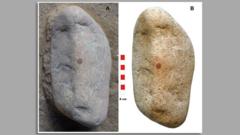Scientists in Spain have made a groundbreaking discovery, unveiling what is believed to be the oldest human fingerprint, providing compelling evidence that Neanderthals engaged in artistic expression. The research team unearthed a rock resembling a human face, indicating that a Neanderthal may have used red pigment approximately 43,000 years ago to paint a nose on the pebble found in the San Lázaro rock shelter in Segovia.
The strategic positioning of the paint dot has led researchers to interpret it as an indication of symbolic behavior, which suggests that Neanderthals possessed an ability to conceptualize ideas abstractly. These findings play a vital role in the ongoing discussion surrounding Neanderthals’ artistic capabilities, according to co-author María de Andrés-Herrero.
In her conversation with the BBC's Newsday, Prof de Andrés-Herrero from the University of Complutense in Madrid shared insights about the excavation, which began five years ago. The pivotal moment came in 2022 when researchers discovered the stone lying beneath 1.5 meters (5 feet) of Neanderthal sediment. “At first, we were astonished by our find. The larger stone, unlike others found on-site, showcased a red dot that resembled a human face,” she described.
After determining that the dot was created using ochre, a natural clay pigment, the research team engaged Spain's scientific police to aid in their analysis. This collaboration led to the identification of a human fingerprint on the stone, which appears to belong to a male adult, although co-author David Álvarez Alonso noted that the lack of comparative Neanderthal prints presents challenges for definitive conclusions.
Spanish official Gonzalo Santonja stated during a press briefing that this pebble represents the oldest known portable painted object in Europe and is the only recognized piece of Neanderthal portable art. Prof de Andrés-Herrero emphasized the significance of this research as it highlights Neanderthals’ symbolic capacities, representing the first documented case of a pigment-marked artifact found in a confirmed archaeological context.
Further analysis suggested that the fingerprint was found in a context devoid of utilitarian purpose, implying that the marking on the pebble was intentionally artistic. Prof Alonso remarked that the Neanderthal likely selected the stone for its intriguing fissures and deliberately applied an ochre stain in the center, as red pigment has not been found naturally in the shelter. In their published research in the journal Archaeological and Anthropological Sciences, the team articulated their belief that the pebble exhibits qualities making it an exceptional visual symbol, potentially classified as portable art under certain interpretations.



















